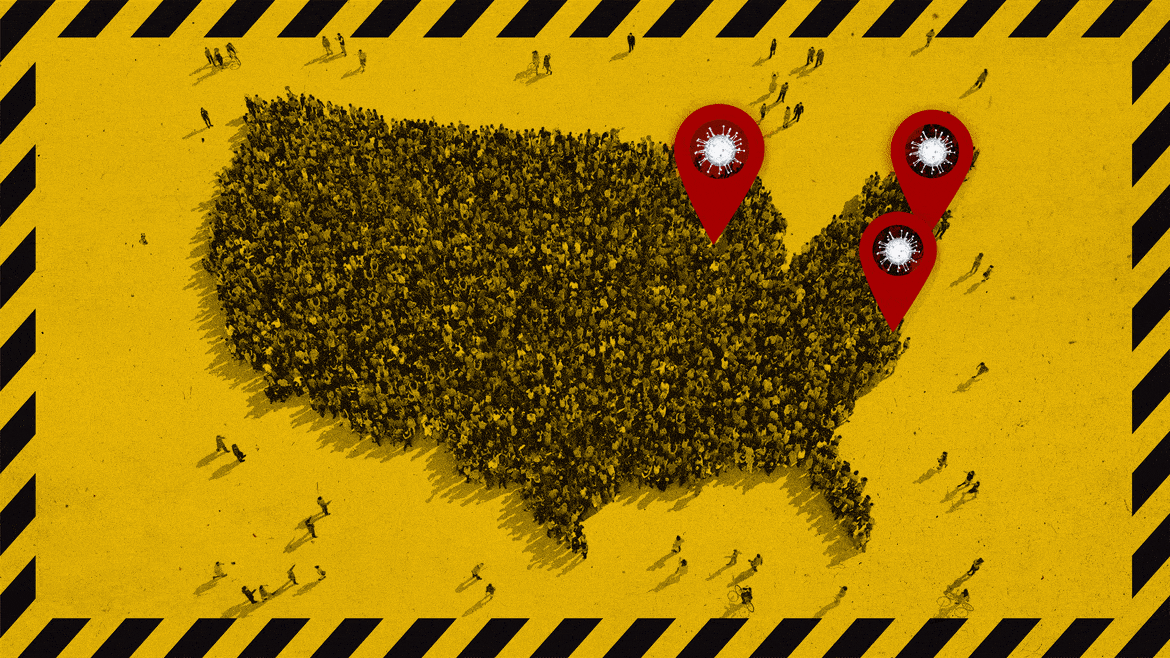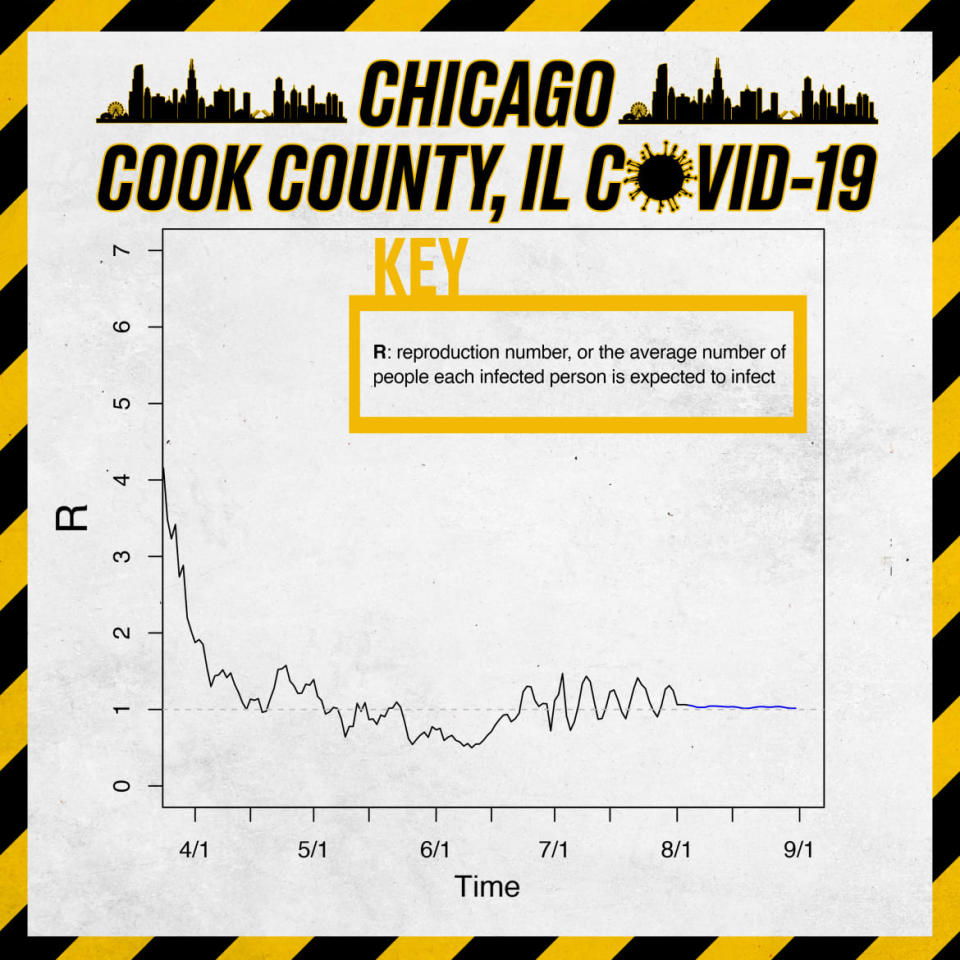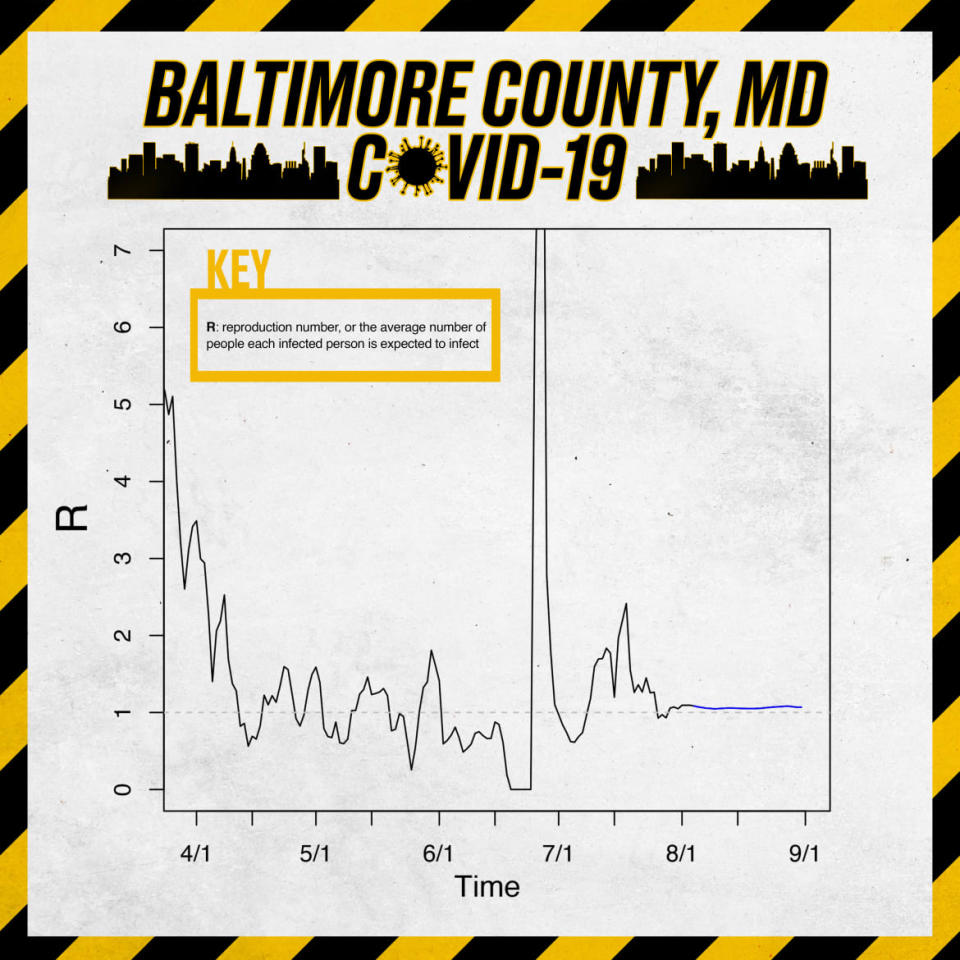Modelers Warn Baltimore, Boston, and Chicago Could Be Next COVID-19 Hot Spots

First it was Seattle. Then New York City. Then the novel coronavirus hit Arizona, Texas, and Florida with a vengeance, infecting hundreds of thousands of people and leading to backlogs of bodies in morgues that are still growing today.
The big question, as the weather begins to turn cold, flu season approaches, and schools reopen across the nation, is a simple one: Which city is next?
The modelers at PolicyLab, the think tank at the Children’s Hospital of Philadelphia (CHOP) whose projections are often used by the White House Coronavirus Task Force, think they have an answer: Baltimore, Chicago, and Boston. The reasons range from density to climate to behavior to demographic factors. But, cumulatively, they have created a dangerous and swelling disease burden within the cities and in their immediate environs, according to PolicyLab models and interviews with a slew of public health experts.
Within any given region, the virus that the United States has been uniquely unable to contain has wrought horror in nursing homes, meatpacking plants, congregate living facilities, vacation destinations, and bars. Now, as the season turns once again, and families and friends prepare for Labor Day festivities while some of the wealthy return from summer retreats and educational institutions strive to reopen, the threat to these areas intensifies.
“Time is running out as we move to the fall,” said Dr. David Rubin, the director of PolicyLab, who shared the new models—which track up to Sept. 1—exclusively with The Daily Beast. “We just don’t know when the match ignites.”
Baltimore
Charm City appears to be in the midst of an escalating outbreak and, according to Rubin, represents a cautionary tale for the other two metro areas in question. The key warning sign was the transmission rate, which breached a crucial threshold in mid-June—and then kept breaching it.

Often referred to by experts as the virus’ reproductive value, or R0, the transmission rate reflects how easily and how often an illness is spreading. To contain a disease, experts generally agree, a locality must keep this value below 1. That is, they must prevent each positive case from creating at least one new case. Once an area exceeds this rate, the virus can proliferate exponentially.
Baltimore City and adjacent Baltimore County oscillated above this bar during the hottest months of the year. In late July, the daily caseload repeatedly broke 200, a height unseen since May. As of Tuesday, in the city of Baltimore, there were 12,704 cumulative confirmed cases of the virus and 430 deaths. In the county, those numbers were 13,400 and 563. Johns Hopkins data showed daily case counts of 157 and 143 respectively.
But the overall trajectory is upward, PolicyLab projects.
This comes in spite of fairly strong social distancing behaviors in the area since the pandemic set in. Using cellphone data, PolicyLab logged a 44 percent drop in trips to nonessential businesses in the city proper (the county lagged in this regard, with such excursions declining by 31.5 percent). Yet it was not enough to prevent a mounting crisis.

Rubin suggested this might be a consequence of Baltimore’s high density, high poverty rate, and large number of multigenerational households. It may also suffer from its proximity to the southern states hurt worst this summer.
“Think about the factors that affect the rate of growth of this virus—it’s about gathering and crowding,” he said. “And it’s exposure times time: the number of exposures and the amount of time spent there.”
In an email on Tuesday, Dr. Letitia Dzirasa, Baltimore City Health Commissioner, declined to weigh in on the PolicyLab projections, but said that the city was taking concerns about the fall and winter months seriously—and was in the process of implementing several policies to that effect.

“In addition to an increased focus and planned messaging campaign around flu vaccinations this fall, Baltimore City recently reduced the capacity of our indoor spaces to 25 percent, down from 50 percent last week, in response to the steady increase of COVID-19 cases locally,” said Dzirasa. “We also implemented a face-covering ordinance, requiring residents to wear face coverings when in public spaces where social distancing is not possible.”
At the same time, the city is “expanding access to mobile community-based testing, with a specific focus on increased testing in our Black and LatinX populations” and working daily to “remind residents about the importance of social distancing, wearing face coverings, and only going out for essential reasons,” said Dzirasa.
Gov. Larry Hogan’s administration pointed The Daily Beast to its efforts to expand testing, and coordinate with federal and local authorities. It highlighted that, while overall cases may be trending upward, the proportion of negative test results has, as well.
“We have worked closely with city health officials to expand testing availability, increase contact tracing capacity, and boost enforcement of public health orders,” said Charles Gischlar, a spokesman for the Maryland Department of Health. “Baltimore City's positivity rate has declined by roughly 30 percent this month, and is near its lowest level of the pandemic.”

Positivity rate reflects the percentage of tests showing the presence of COVID-19 or the responsive human antibodies. Scientists note that this figure often drops as testing initially expands beyond the most symptomatic individuals.
To be clear, though, the city’s positivity rate may have decreased substantially in recent weeks—but it’s still at 5.3 percent, which is slightly above the state’s own. According to Johns Hopkins, the state’s testing rate per citizen is also trending downward and does not, even with the progress it has made since the beginning of the pandemic, meet the World Health Organization’s criteria for testing. For comparison, according to Johns Hopkins, the District of Columbia is at 2.3 percent positivity, and New York state is at a 0.9 percent positivity rate.
But Baltimore has climate on its side: late and comparatively mild winters. It will be months before people there huddle indoors to escape the cold, and before chilly air keeps viral particles afloat longer, increasing the likelihood of infection.
That can’t be said of the other cities on this list.
Chicago
As of Tuesday, Cook County’s cumulative confirmed case count stood at 111,948, with 4,928 total deaths. The county saw a daily case count of more than 500, a substantial uptick from where the Midwestern giant stood in June, though well below the daily toll in April and May.
But what worries the experts at PolicyLab about Chicago is, again, the transmission rate, which cracked 1 in encompassing Cook County at the end of June, prefiguring a sharp increase in the overall number of cases in July. Worse yet, the modelers found that residents of the 5.15 million-strong metropolitan area were not social distancing at anything near the rate needed to curb the spread.

Trips to nonessential businesses have fallen by less than a third of their pre-pandemic levels—well below the 50 percent decline Rubin, following White House Coronavirus Response Coordinator Dr. Deborah Birx, recommends, according to cellphone data.
Then there is the approach of the infamous Windy City winter.
“Cook County is going to get colder quickly,” said Rubin. “They’re clearly growing again. They’re not doing enough distancing, and their numbers are creeping up. If they don’t get their case counts down, they have plenty of room to grow again.”
Additional risk factors include Labor Day travel to the Chicago area from the surrounding Midwest, where fractious state governments have often failed to impose and enforce strong regulations on personal and business activity. The wave of major civil disruptions over police attacks on Black people, the most recent of which occurred in Chicago on Monday, might also further inflame a viral hot spot in the weeks ahead—as Rubin suggested may be playing out in Portland, Oregon. (There is no strong evidence as yet, it should be noted, that outdoor protests over police brutality have substantially propagated COVID-19.)

“Whenever those incidents happen, with a high disease burden, you have to expect there’s going to be an impact,” said Rubin. “Once you are growing and you have these large gatherings, whether it’s a protest or whether it’s a festival or whether it’s a house party, there's going to be increased transmission.”
Neither city or state authorities, nor the Cook County Health and Hospitals System, responded to requests for comment by press time.
Boston
The Boston area is currently the mildest case of the three cities PolicyLab highlighted, relative to its population. As of Tuesday, Suffolk County, Massachusetts, had a cumulative 21,929 confirmed cases of the virus and 1,074 deaths, with only about 80 new cases per day, according to data from Johns Hopkins. This may owe to an aggressive early response, coupled with an impressive 54 percent fall in nonessential trips inside the county, according to cellphone data. The current daily case counts in Essex, the county just north of Suffolk, were even lower.
But examining the underlying transmission rate, and the broader metropolitan map, Rubin fears the city may suffer from overconfidence. Excursions for leisure or pleasure are at two-thirds their pre-pandemic levels in nextdoor Middlesex County, and at nearly 75 percent in Essex. And across eastern Massachusetts, the transmission rate is projected to hold at or above 1.
This consistency is significant. An isolated flare-up—at a jail or a factory, for instance—would produce a brief, sharp spike in the transmission rate and caseload. What Rubin sees in the Boston area is a large, fertile, and festering breeding ground for an autumn outbreak.
“Boston has looked better than much of the country, and they’ve escaped scrutiny,” said Rubin, before issuing another note of caution. “They’re growing as quickly as other parts of the country, just from a lower numerator.”
Average fall temperatures are not much higher in Boston than they are in Chicago. And the city is contemplating reopening its schools. Combined, these factors could result in the nation’s epidemiological epicenters migrating back from the South to the Northeast.
“If Dallas got its cases down, I’d much rather be Dallas than Boston now. Or Miami. Or Phoenix. Because they have more temperate weather,” said Rubin.
Neither the Boston Public Health Commission nor the offices of Gov. Charlie Baker and Mayor Marty Walsh responded to requests for comment by The Daily Beast on Tuesday. But Boston Children’s Hospital’s Chief Innovation Officer John Brownstein was clear-eyed and calm during an interview with The Daily Beast.
“We’re not in a bad spot,” argued Brownstein. “Clearly it’s not perfect, but in this state there’s a huge alignment between scientists and government and a belief that the data should drive how we proceed.”
“Again, things can change in the coming weeks,” said Brownstein. But “if you’re in a community where people are ringing alarm bells at these early stages, that’s a great sign for their ability to keep things under control.”
“Yes, it’s a concern to see early increases,” he added. “But we are as prepared as we possibly can be because we’re so tuned in to the daily numbers.”
Dr. Arnold Monto, a professor of epidemiology and global health at the University of Michigan, agreed that colder weather, flu season, and in-person schools are certainly worrisome factors. But Monto noted that seasonal flu “doesn’t really start until November” and that if communities maintain social distance appropriate for COVID, that should go a long way toward preventing a significant flu pandemic.
Schools, on the other hand, said Monto, are “a real concern.”
“We know that there is infection and transmission in younger people, though it is at a lower level,” said Monto. “Some people are more risk-averse than others. Teenagers tend not to be, and there’s also been mixed messaging about the dangers in that population.”
But ultimately, he said, “I can’t emphasize enough that there are many examples of young adults developing severe disease, which they often survive, but may require long-term care.”
Even with all that is known about the virus as it relates to congregate settings, the flu, and cold weather, outbreaks projected in models are never a guarantee. Skeptics have panned some COVID-19 models for fearmongering or for oversimplifying the factors that go into outbreaks, but at least one expert argued that models should be viewed as a “tool that helps us to reason clearly and transparently”—while acknowledging their limits.
“What are the alternatives to models?” asked Dr. John Drake, a professor at the University of Georgia’s Center for Ecology of Infectious Disease who is known for his expertise in predictive models.
Expert opinion and raw data are the alternatives, said Drake. “But you can’t have raw data about things you haven’t observed, like the number of infections—which is greater than the number of cases—or what will happen in the future,” he said.
To be clear, argued Drake, “Some models are better than others, and all of them rely on various assumptions. In the case of the coronavirus pandemic, a number of variables—ranging from the rate of transmission to the fatality rate—are poorly understood.”
What that means, said Drake, is that “models are never perfect representations of nature” even if “they are a valuable tool.”
Rubin’s recommendation, in the spring and now, is to establish uniform national rules and enforcement for mask utilization and social distancing—preventing suburban travelers and commuters from bringing the disease into already-troubled cities. These should follow the standards established in states such as Michigan and New York that successfully suppressed the disease earlier this year. Further, he argued most schools and universities should wait until October before bringing students back on campus, in order to wait out any rash of cases brought on by Labor Day festivities.
For Boston, Chicago, and Baltimore, he highlighted the example of Atlanta, which held out against the disease pressure of the encircling region weeks longer than anticipated. He credited this to a successful public relations effort that joined elected leaders with prominent citizens in observing and encouraging mask usage and social distancing.
“Atlanta was surrounded not by storm clouds but by hurricanes,” he said. “I think a large reason why Atlanta didn’t grow for a long time was that there’s been some consensus about protecting each other. It would be great to have influential coaches, athletes, celebrities really galvanizing around a public relations campaign.”
In the spring, as Rubin noted, speaking about the nationwide picture, “we opened too quickly and didn’t fully degrade our counts.” So the next few months will be an opportunity to discover if Americans have learned anything. “If we see declining counts in the fall, are we going to rush kids back into school? I know it might feel like things are getting better, but if we learned anything, we would wait a few weeks to make sure that things have gone down,” he argued.
“There’s going to be this incredible pressure,” predicted Rubin. “‘Give me more bar capacity,’ ‘Get my schools back open.’ People are going to make the same mistakes twice, and we’re going to see a lot of variability.”
“To me, it sets up the dynamic for us repeating mistakes, for us not learning from what happened in May or June,” said Rubin. “And the vaccine isn’t going to bail us out.”
Got a tip? Send it to The Daily Beast here
Get our top stories in your inbox every day. Sign up now!
Daily Beast Membership: Beast Inside goes deeper on the stories that matter to you. Learn more.

